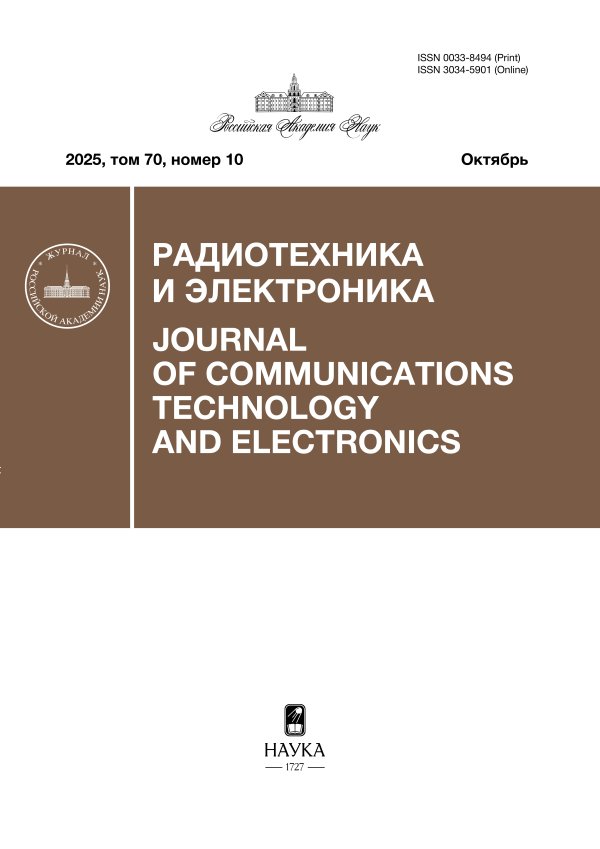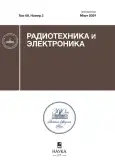Трансформация электромагнитных полей в сверхширокополосных антенных решетках
- Авторы: Банков С.Е.1, Дупленкова М.Д.1
-
Учреждения:
- Институт радиотехники и электроники им. В. А. Котельникова РАН
- Выпуск: Том 69, № 3 (2024)
- Страницы: 207-216
- Раздел: АНТЕННО-ФИДЕРНЫЕСИСТЕМЫ
- URL: https://gynecology.orscience.ru/0033-8494/article/view/650696
- DOI: https://doi.org/10.31857/S0033849424030011
- EDN: https://elibrary.ru/JVRVFC
- ID: 650696
Цитировать
Полный текст
Аннотация
Рассмотрены бесконечные сверхширокополосные решетки ТЕМ-рупоров и антенн Вивальди. На первом этапе была использована модель решетки в режиме квазипериодического возбуждения в виде канала Флоке, которая реализована в системе электродинамического моделирования HFSS. На втором этапе по рассчитанной матрице рассеяния канала Флоке определены параметры решетки в режиме кластерного возбуждения, в том числе распределение части полного поля — поля излучения в апертуре решетки. Проанализированы два кластера: конечные по одной координате и бесконечные по другой. Исследовано влияние на форму амплитудного распределения поля излучения в апертуре таких факторов, как размер кластера, частота, амплитудное распределение возбуждающих волн, сканирование в секторе углов. Показано, что распределение поля в излучающей апертуре может существенно отличаться от распределения возбуждающих волн на входах излучателей решетки. Предложено объяснение данного эффекта, основанное на представлении поля в решетке в виде суперпозиции ее собственных волн.
Ключевые слова
Полный текст
Об авторах
С. Е. Банков
Институт радиотехники и электроники им. В. А. Котельникова РАН
Email: duplenkova@yandex.ru
Россия, ул. Моховая, 11, стр. 7, Москва, 125009
М. Д. Дупленкова
Институт радиотехники и электроники им. В. А. Котельникова РАН
Автор, ответственный за переписку.
Email: duplenkova@yandex.ru
Россия, ул. Моховая, 11, стр. 7, Москва, 125009
Список литературы
- Иммореев И.Я. // РЭ. 2009. Т. 54. № 1. С. 5.
- Haghpanah M., Kashani Z.G., Param A.K. // 30th Intern. Conf. on Electrical Engineering (ICEE). IEEE. 2022. P. 42.
- Panzer B., Gomez-Garcia D., Leuschen C. et al. // J. Glaciology. 2013. V. 59. № 214. P. 244.
- Rodriguez-Morales F., Gogineni S., Leuschen C.J. et al. // IEEE Trans. 2013. V. GRS-52. № 5. P. 2824.
- Patel A., Paden J., Leuschen C. et al. // IEEE Trans. 2014. V. GRS-53. № 5. P. 2547.
- Liu H., Yang Z., Yue Y. et al. // NDT & E International. 2023. V. 133. Article No. 102726.
- Yarovoy A.G., Ligthart L.P. // Proc. Int. Symp. on Antennas for Radar Earth Observation. Delft. 8–9 Jun. 2000. Delft: Univ. of Technology.
- McGrath D.T., Baum C.E. // IEEE Trans. 1999. V. AP-47. № 3. P. 469.
- Elmansouri M.A., Ha J., Filipovic D.S. // IEEE Trans. 2017. V. AP-65. № 3. P. 1374.
- Elmansouri M.A., Filipovic D.S. // IET Microw. Antennas Propag. 2017. V. 11. № 15. P. 2134.
- Калошин В.А., Ле Н.Т., Фролова Е.В. // Журн. радиоэлектроники. 2020. № 4.http://jre.cplire.ru/jre/apr20/2/text.pdf
- Fedorov V.M., Efanov M.V., Ostashev V.Y. et al. // Electronics. 2021. V.10. № 9. Article No. 1011.https://doi.org/10.3390/electronics10091011
- Банков С.Е., Дупленкова М.Д. // РЭ. 2018. Т. 63. № 1. С. 25.
- Банков С.Е., Калошин В.А., Нгуен К.З. // РЭ. 2018. Т. 63. № 7. С. 702.
- Банков С.Е., Калошин В.А., Ле Н.Т. // РЭ. 2018. Т. 63. № 12. С. 1263.
- Амитей Н., Галиндо В., Ву Ч. Теория и анализ фазированных антенных решеток. М.: Мир, 1974.
- Банков С.Е., Курушин А.А., Гутцайт Э.М. Решение оптических и СВЧ задач с помощью HFSS. М.: Оркада, 2012.
- Каценеленбаум Б.З. Теория нерегулярных волноводов с медленно меняющимися параметрами. М.: Изд-во АН СССР, 1961.
- Банков С.Е., Скородумова Е.А. // РЭ. 2015. Т. 60. № 5. С. 470.
- Банков С.Е., Дупленкова М.Д. // РЭ. 2015. Т. 60. № 6. С. 618.
- Грачёв Г.Г., Калошин В.А. // Журн. радиоэлектроники. 2020. № 1.http://jre.cplire.ru/jre/jan20/6/text.pdf.
- Bankov S.E., Duplenkova M.D. // IEEE8th All-Russian Microwave Conf. (RMC). Moscow, Russian Federation. 2022. P. 178.https://doi.org/10.1109/RMC55984.2022.10079619
- Корн Г., Корн Т. Справочник по математике для научных работников и инженеров. М.: Наука, 1977.
Дополнительные файлы





















